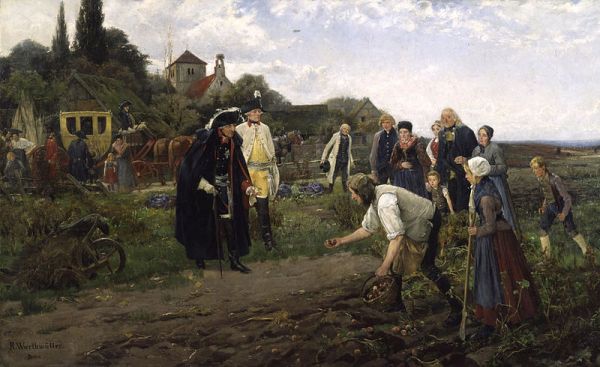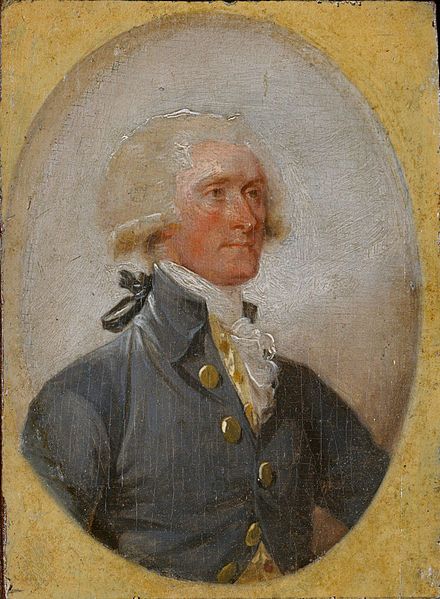6 Brazen Acts of Culinary Thievery

King Frederick inspects the potato crops.
1. POTATO PUSHERThe potato came to Europe in the late 1500s, but it wasn’t met with a warm welcome. Disregarded by most, it was first used only to feed livestock. But Frederick the Great of Prussia saw the tuber’s potential. Sure, potatoes tasted bland, but they were versatile, cheaper than bread, and easy to stockpile. He introduced them to his army in 1744 and later freely distributed them to peasants during famine. The people weren’t convinced. In fact, the town of Kolberg was so put off that it responded in a letter: “The things have neither smell nor taste, not even the dogs will eat them, so what use are they to us?” To change public opinion, King Frederick employed some reverse psychology and established a royal potato field patrolled by soldiers. Soon, curious citizens were slinking around at night with stolen potatoes to plant in their gardens -exactly what Frederick wanted.
2. THE RICEMAN COMETH
 Thomas
Jefferson knew how important healthy farms were to his fledgling
nation, and he didn’t mind getting his hands dirty to keep his country
strong. By summer 1787, the American rice industry was starting to
crumble. The rice was mostly grown in swamps, and the stagnant water was
a breeding ground for mosquitoes that made nearby workers sick. During
his tenure as minister to France, Jefferson found the farmers’ solution:
a dry, upland variety of rice grown in Italy. There was just one
problem: Italian law forbade “the exportation of rough rice on pain of
death.” Jefferson, however, used his power to declare the rice
independent, secretly filling his coat pockets with the unhusked
varietel before making for the border.
Thomas
Jefferson knew how important healthy farms were to his fledgling
nation, and he didn’t mind getting his hands dirty to keep his country
strong. By summer 1787, the American rice industry was starting to
crumble. The rice was mostly grown in swamps, and the stagnant water was
a breeding ground for mosquitoes that made nearby workers sick. During
his tenure as minister to France, Jefferson found the farmers’ solution:
a dry, upland variety of rice grown in Italy. There was just one
problem: Italian law forbade “the exportation of rough rice on pain of
death.” Jefferson, however, used his power to declare the rice
independent, secretly filling his coat pockets with the unhusked
varietel before making for the border. 3. CROSS YOUR TEAS
4. A SAUCY CLAIM
Tabasco is arguably the most widespread hot sauce this side of the Rio Grande, but its origins are somewhat murky. Tabasco was founded in 1868 by Edmund McIlhenny, who first sold the spicy stuff in used cologne bottles. his company has been the lone producer ever since. But rumored have long swirled that McIlhenny stole the famous formula from a purported friend, a man named Colonel Maunsel White, who supposedly had a “Concentrated Essence of Tobasco [sic] Pepper” of his own. (White believed it could fend off cholera.) The Tabasco Company concedes that White did produce a pepper sauce years before McIlhenny but argues that it’s just a coincidence and that the men never met. Despite the denials, the saucy rumors remain to this day.
In 2008, a cook at Brooklyn restaurant Junior’s was caught with his tail between his legs. A few tails, actually. A co-worker noticed 40-year-old Raymond Flores stuffing lobster tails -15 in all- down his pants and securing them with bandages. Flores was charged with petit larceny and criminal possession of stolen property. The fact that his clothes smelled like clambake made it easier to swallow the fact that he lost his job, too.
6. THE GREAT CHEESE CAPER
Dairy may be perishable, but that doesn’t make it any less attractive to thieves. In 2009, a duo in New Zealand was caught stealing 20-kilo blocks of cheese from a train. During the ensuing car chase, the couple tried throwing off the cops by tossing boxes of vacuum-packed cheddar out the window. More recently, an Illinois man stole an impressive 21 tons of Muenster valued at around $200,000. It turns out, cheese is one of the world’s most “high risk foods.” That doesn’t mean it might make you sick -it indicates how likely it is to be stolen. According to a 2011 report from the Center for Retail Research, about 4 percent of the world’s supply has been pilfered!

No comments:
Post a Comment